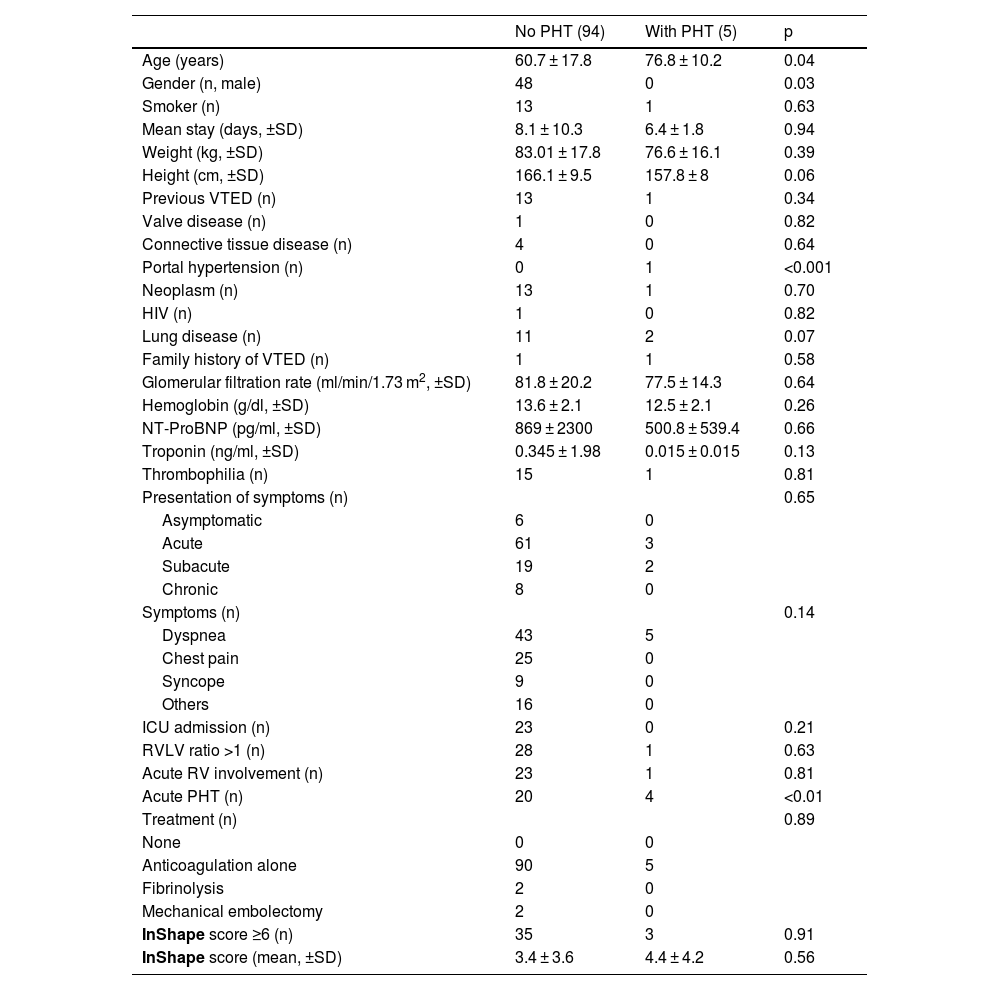The most severe long-term complication of pulmonary embolism (PE) is chronic thromboembolic pulmonary hypertension (CTEPH), and its early diagnosis often requires numerous diagnostic tests. The InShape II study proposes an early screening algorithm that aims to reduce the number of echocardiographic studies. The objective of our study is to validate this algorithm in our patient cohort.
Materials and methodsWe retrospectively analyzed patients admitted to Hospital Rey Juan Carlos between November 2017 and February 2020, who were diagnosed with PE based on computed tomography angiography (CTA). Patients were followed for at least one year, and clinical, laboratory, and complementary test data were collected at three months and one year. The InShape II algorithm was applied to these patients to validate its results.
ResultsDuring the study period, 236 patients were diagnosed with PE, of which 137 were excluded. The algorithm was validated in 99 patients. Applying the InShape II score, 19 echocardiograms would have been performed (three of them with intermediate-high probability of CTEPH), while 80 echocardiograms would have been avoided (two of them with intermediate-high probability). This yielded a sensitivity of 60% and a specificity of 83% for the score, with an area under the curve (AUC) of 0.715 (95% CI: 0.472–0.958).
ConclusionsOur results support the notion that the InShape II algorithm could be a useful tool for initial screening of CTEPH in low-incidence settings, as it would avoid unnecessary echocardiograms that do not provide additional value.
La complicación a largo plazo más grave del embolismo pulmonar (EP) es la hipertensión pulmonar tromboembólica crónica (HPTEC), cuyo diagnóstico precoz implica la realización de un gran número pruebas. El estudio InShape II propone un algoritmo de cribado precoz que pretende disminuir el número de estudios ecocardiográficos. El objetivo de nuestro estudio es validar este algoritmo en nuestra cohorte de pacientes.
Material y métodosSe analizaron retrospectivamente los pacientes ingresados con diagnóstico de EP por angio-TC, en el Hospital Rey Juan Carlos entre noviembre del 2017 y febrero del 2020, seguidos durante al menos un año. Se recogieron datos clínicos, analíticos, y pruebas complementarias a los 3 meses y al año. Se aplicó a estos pacientes el algoritmo del estudio InShape II para validar sus resultados.
ResultadosEn el periodo de estudio fueron diagnosticados de EP 236 pacientes, de los cuales 137 fueron excluidos. Se validó el algoritmo en 99 pacientes. Aplicando el score del InShape II hubiéramos realizado 19 ecocardiogramas (3 de ellos con probabilidad intermedia/alta de HPTEC) y no se hubieran hecho en 80 (2 de ellos con probabilidad intermedia/alta), por lo que se estableció una sensibilidad del score de un 60%, con una especificidad de un 83%, y un área bajo la curva (AUC) de 0,715 (IC 95%: 0,472–0,958).
ConclusionesNuestros resultados apoyan que el algoritmo del estudio InShape II podría ser una herramienta útil en el cribado inicial del estudio de HPTEC en entornos de baja incidencia, ya que evitaría la realización de ecocardiogramas que no aportan valor.
Article
Diríjase desde aquí a la web de la >>>FESEMI<<< e inicie sesión mediante el formulario que se encuentra en la barra superior, pulsando sobre el candado.

Una vez autentificado, en la misma web de FESEMI, en el menú superior, elija la opción deseada.

>>>FESEMI<<<










